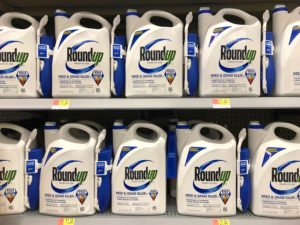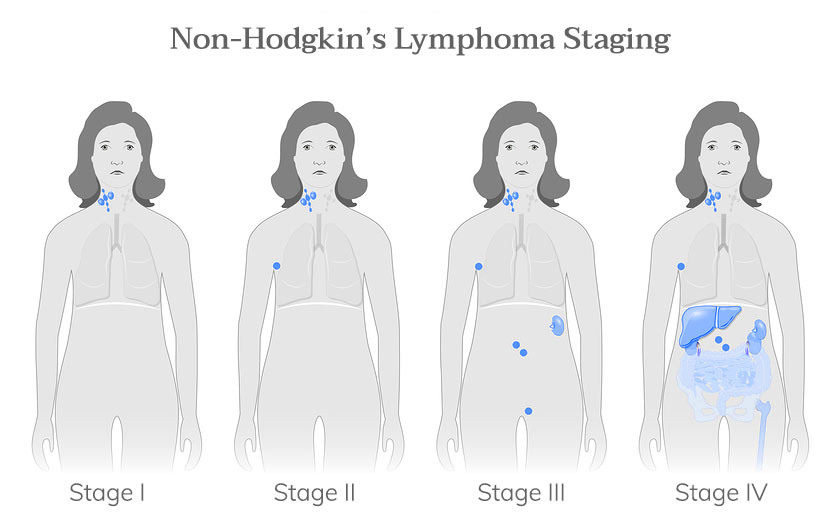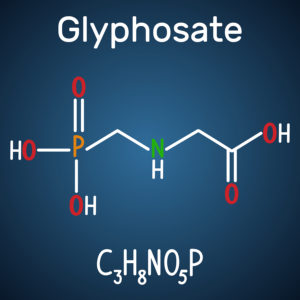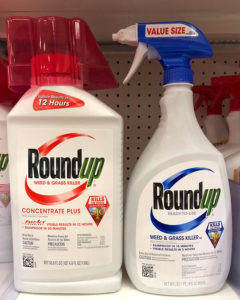
Roundup has been linked to multiple lymphatic cancers.
Roundup and its key ingredient, glyphosate, have been linked to several types of cancer, including non-Hodgkin's lymphoma (NHL), b-cell lymphoma and leukemia. As a result, thousands of people have filed lawsuits claiming the popular weed killer caused them to develop cancer.
Glyphosate, the weed-killing active ingredient in Roundup, stands at the center of these lawsuits. Court proceedings in some of the earliest Roundup trials revealed close interactions between Monsanto--the manufacturer of Roundup--and the Environmental Protection Agency (EPA).
These interactions have cast doubt on the EPA's glyphosate rulings. Internal Monsanto documents also demonstrate repeated attempts, some successful, to manipulate published scientific studies and media reports in favor of glyphosate safety.
Keep reading to learn the facts about Monsanto, Roundup, glyphosate, non-Hodgkin's lymphoma, and how they figure in thousands of lawsuits.
Roundup Weed Killer Lawsuits
In 1970, agricultural giant Monsanto developed glyphosate as a potent herbicide. Monsanto marketed the chemical as Roundup Weed Killer. By 2007, it had become the most used herbicide in the United States. An estimated 1.4 billion pounds of Roundup are used in more than 160 countries each year.
Despite its widespread use, the popular weedkiller has been called into question as a possible health hazard. Thousands of consumers have filed Roundup cancer claims alleging they developed non-Hodgkin's lymphoma, b-cell lymphoma, leukemia or other forms of cancer after using the weed killer.
The first non-Hodgkin's lymphoma lawsuit came before a jury in 2018, resulting in a landmark $289 million verdict against Monsanto. The award has been reduced twice, but the plaintiff, Dewayne Johnson, and his family should receive $20 million.
In 2018, just as these lawsuits were beginning to come before juries, Bayer finalized their acquisition of Monsanto. According to public statements, Bayer faces 125,000 Roundup lawsuits. Plaintiffs claim the herbicide caused users to develop blood cancer.
Types of Blood Cancer Claimed in Roundup Lawsuits
|
Roundup Wrongful Death Lawsuits
In some cases, individuals impacted by repeated Roundup exposure may have already passed away before they or their family members understood the link between Roundup and cancer. Family members of those who passed away from Roundup-associated cancer may be able to file a wrongful death lawsuit.
Learn more about wrongful death lawsuits >>>
Roundup Class Actions & Multidistrict Litigation (MDL 2741)
A Roundup class action lawsuit was filed in Los Angeles Superior Court against Monsanto, claiming its advertising falsely stated that Roundup products were safe to use. The class action lawsuit also claims the company deliberately falsified documents and concealed information indicating that glyphosate is dangerous to humans and environmental health.
Roundup Multidistrict Litigation (MDL 2741)
Due to the growing number of Roundup cancer lawsuits, federal multidistrict litigation has been consolidated under MDL No. 2741 under U.S. District Judge Vince Chhabria in the Northern District of California. There are more than 3,800 lawsuits pending under the multidistrict litigation as of August 2020.
Note: Bayer's public references to 125,000 Roundup lawsuits indicate the vast majority have not been officially filed in the MDL.
In April 2019, Judge Chhabria ordered Monsanto to enter into mediation with plaintiff attorneys. In June 2020, Bayer announced a $10.9 billion settlement. Roughly $8.8 to $9.6 billion would be used for current claims. $1.25 billion would be reserved for future litigation.
As of October 2020, this settlement is still pending.
Learn more about Bayer's pending settlement here >>>
Roundup Cancer Settlements, Verdicts and Compensation Amounts
Though there have been no Roundup settlements at this time, several Roundup trials have resulted in verdicts favoring the plaintiffs.
Dewayne Johnson v. Monsanto | $20 Million
Plaintiff Dewayne Johnson is a former school groundskeeper for a California county school system. He was diagnosed with non-Hodgkin's lymphoma after years of using Roundup weed-killer and other glyphosate-based herbicides. According to Johnson, he used the product as many as 30 times per year and, on at least two occasions, spilled a substantial amount of the chemical on his body.
In January 2016, Johnson filed a Roundup lawsuit against Monsanto, claiming his use of Roundup contributed significantly to the development of his cancer. Because he was diagnosed with terminal cancer, California state law allowed Johnson to seek a fast-track lawsuit--though, the case still took nearly two and a half years to reach trial.
He built his case around the classification of glyphosate as "probably carcinogenic to humans" by the International Agency for Research on Cancer. He also noted that not enough testing has been done on Roundup's formulation, which includes other chemicals in addition to glyphosate.
On August 10, 2018, the San Francisco jury returned with a verdict that awarded Mr. Johnson $289 million ($39 million in compensatory damages and $250 million in punitive damages) in his Roundup case. Monsanto appealed, asking for a new trial. However, in October 2018, a judge ruled against Monsanto, and the final amount awarded to Mr. Johnson and his family was $78.5 million.
Bayer AG appealed the 2018 award. In July 2020, an appeals court supported the current verdict in favor of Johnson. However, the appeals court further reduced the award by 74%. Johnson will instead receive $20.5 million.
Read more about the first Roundup verdict >>>
Edwin Hardeman v. Monsanto | $25 Million
70-year-old Edwin Hardeman used Roundup from the 1980s through 2015, when he was diagnosed with non-Hodgkin's lymphoma. Hardeman filed his lawsuit in 2016, claiming Monsanto ignored and withheld evidence of Roundup's link to cancer. The company also failed to warn consumers of the potential hazards of the weedkiller, according to Hardeman's legal complaint.
In March 2019, a San Francisco jury decided unanimously in favor of Hardeman, confirming Roundup was a "substantial factor" contributing to Hardeman's lymphoma diagnosis. About a week after the verdict, the jury awarded $80 million to Hardeman in the damages phase of his cancer lawsuit, finding that Monsanto had failed to warn him and other consumers about the potential dangers of the Roundup formula.
In July 2019, an appeals court reduced the value of this award to $25 million.
Read more about the Hardeman verdict >>>
Alva and Alberta Pilliod v. Monsanto | $2 Billion
In court proceedings, the Pilliods testified to using Roundup regularly, starting in 1982. The couple used the consumer version of the weedkiller, whose label lacked any warnings about covering skin or wearing protective masks.
Alva was diagnosed with non-Hodgkin's lymphoma in 2011. Four years later, Alberta was also diagnosed with NHL. The Pilliods said they used Roundup because they believed it was safe. Alberta even wore shorts while spraying Roundup, because she had seen a man in a Roundup commercial doing the same thing.
The jury determined that Monsanto acted maliciously and awarded the Piliods $55 million in compensatory damages and $2 billion ($1 billion each) in punitive damages.
Monsanto & Roundup Lawsuit News
With the global popularity of Roundup, the number of lawsuits may continue climbing for some time. Updates will be posted below as case developments occur.
03-04-21 | Bayer Proposes $2 Billion to Settle Future Roundup Lawsuits
06-25-20 | Bayer Agrees to $10.9 Billion Roundup Settlement
07-26-19 | $2 Billion Roundup Verdict Reduced to $86.7 Million
06-14-19 | Is Roundup Dangerous? Can Weed Killer Cause Cancer?
05-14-19 | Historic Roundup Verdict Awards $2 Billion to Couple with Cancer
03-21-19 | 2nd Roundup Verdict Goes Against Monsanto
10-23-18 | Judge Reduces $289 Million Award, Denies Monsanto Retrial Request
08-28-18 | $289 Million Roundup Verdict; Monsanto Faces 8,000 More Cases
07-12-18 | Roundup Cancer Lawsuits Can Move Forward
How Much Does Filing a Roundup Lawsuit Cost?
If you have a viable case, you may be able to work with a law firm on a contingency basis. This means you will only be required to pay if the legal team secures a settlement or verdict on your behalf. You will not need to pay any fees upfront.
The Roundup Cancer: Non-Hodgkin's Lymphoma
Non-Hodgkin's Lymphoma (NHL) is a form of lymphatic system cancer linked to Roundup and glyphosate exposure. In healthy individuals, the lymphatic system transports infection-fighting white blood cells throughout the body.
In individuals with NHL, some of those white blood cells turn into tumors. NHL comes in several different forms, as described in the table below.
Types of Non-Hodgkin's Lymphoma
Chronic Lymphocytic Leukemia (CLL)
CLL, the most common adult leukemia, develops when white blood cells become cancerous. Starting in their place of origin, bone marrow, these cancer cells malfunction and live longer than normal. This allows them to crowd other healthy cells and build up over time.The CLL cancer cells eventually overflow into the bloodstream and travel to other parts of the body. Once they land in other parts of the body, they can build up and crowd healthy cells in those locations as well.
Cutaneous B Cell Lymphoma (CBCL)
CBCL is a rare form of blood cancer that develops from a specific type of white blood cell, the B cell. Healthy B cells help fight infection by making antibodies. Cancerous B cells, those found in CBCL, turn on the body and attack skin cells. CBCL may look like a raised skin nodule with normal, pink or purple coloring.
Cutaneous T Cell Lymphoma (CTCL)
CTCL is another form of blood cancer, but it develops from a different type of white blood cell: the T cell. Healthy T cells perform a number of functions within the immune system, including killing virus-infected cells. In CTCL, cancerous T cells attack healthy skin, causing rashes, scaly skin and skin tumors.
Follicular Lymphoma
Like CBCL, follicular lymphoma (FL) stems from cancerous B cells. However, with FL, the cancer cells accumulate within the lymphatic system, creating tumors (called follicles) inside lymph nodes. Follicular lymphoma can progress fairly slowly, and tumor growth rate may fluctuate.
Waldenstrom Macroglobulinemia
Waldenstrom macroglobulinemia occurs when B cells--a type of white blood cell--become cancerous. In this form of Non-Hodgkin's Lymphoma, cancerous B cells multiply too quickly and produce large amounts of faulty antibodies (macroglobulins).The fast-growing cancer cells make it difficult for the body to produce healthy blood cells. This can cause anemia and clotting problems. Physicians consider Waldenstrom macroglobulinemia to be a slow-growing lymphoma.
Non-Hodgkin's Lymphoma Symptoms

NHL can affect multiple parts of the lymphatic system (shown above).
Each form of NHL may cause unique symptoms. But people with NHL commonly experience the following symptoms:
- Breathing difficulty
- Chest pain
- Chronic fatigue
- Coughing
- Fever
- Night sweats
- Pain or swelling of the abdomen
- Swollen lymph nodes, which are typically not painful
- Weight loss
The Mayo Clinic advises anyone experiencing worrisome NHL symptoms to make an appointment with a physician.
Non-Hodgkin's Lymphoma Treatment
Before starting any treatment regimen, a physician will confirm the NHL diagnosis, including the specific type of NHL. Diagnosis may include physical exams, blood tests, x-rays and other imaging, lymph node biopsies and bone marrow tests.

| NHL Stages |
| Stage I: Cancer cells are found only in a single lymph node or a close cluster of nodes.
Stage II: Cancer cells are found in either two lymph node areas or one lymph node and a nearby organ; cancer cells are still found in only one bodily section, either above or below the diaphragm (not both). Stage III: Cancer cells are found above and below the diaphragm. Stage IV: Cancer cells are found in multiple organs or tissues. |
| NHL Symptom Grading |
| A: Patient has no significant NHL symptoms.
B: Patient has significant NHL symptoms |
Once doctors confirm an NHL diagnosis, they prescribe the appropriate course of treatment for each patient's specific type of NHL.
Slow-Growing NHL: Treatment May Be Optional
When physicians determine that a particular patient's NHL progresses slowly (indolent NHL), they may not immediately prescribe a treatment. In cases like this, patients typically experience few to zero symptoms from their NHL.
Doctors will usually schedule periodic checkups for indolent NHL. This allows patients to undergo treatment if and when symptoms arise without subjecting them to unnecessary medical interventions.
Symptomatic NHL Treatment
For patients experiencing symptoms from NHL, doctors may prescribe traditional cancer treatments like chemotherapy and radiation. Doctors may also recommend bone marrow transplants, biological therapies or clinical trials.
NHL Prognosis
The five-year survival rates for NHL range from 55% to 95% depending on the specific type and grade of NHL.
You can learn more about specific survival rates from Cancer.org >>>
The Link Between Non-Hodgkin's Lymphoma and Roundup
Thousands of lawsuits have been filed against Roundup manufacturers Monsanto and Bayer, many claiming that the popular weed killer caused the plaintiff's non-Hodgkin's lymphoma. But does a weed killer found on the shelves of most grocery stores really cause cancer?
The answer depends on whom one asks, and their affiliations. Scientific studies completed by independent scientists seem to find a link between high levels of glyphosate exposure and NHL. Studies completed by individuals with ties to Monsanto seem unable to find such a link.
Independent Study
In 2014, researchers analyzed 44 different scientific publications, covering 32 years worth of data on NHL and pesticide exposure. These researchers found a relationship between glyphosate exposure and B cell lymphoma, a type of NHL. Glyphosate is the active ingredient in Roundup weed killer.
Independent Study
In 2008, a study of Swedish citizens who were exposed to a number of pesticides came to a similar conclusion. After analyzing data from nearly 2,000 individuals, researchers concluded glyphosate exposure doubled an individual's likelihood of developing NHL.
Independent Study
In February 2019, researchers at the University of Washington examined the relationship between NHL and high, long-term exposure to glyphosate. They concluded that high exposure to glyphosate increased a person's risk of NHL by 41%.
Several Monsanto-affiliated studies have concluded there is insufficient evidence to confirm a link between NHL and glyphosate exposure.
For more information on glyphosate studies and possible bias, read the scientific study section below.
Glyphosate: Weed Killer or Carcinogen?
The molecule at the center of the Roundup debate is a pretty small one. Despite its size, glyphosate has caused big problems for consumers who used it, and for its manufacturers, Monsanto and Bayer.

Glyphosate may be a small molecule, but it's causing big problems for Monsanto and Bayer.
A Monsanto chemist discovered the plant-killing properties of glyphosate nearly half a century ago. As that scientist would learn, this small molecule inhibits an enzyme necessary for growing plants to stay alive.
For people concerned with weed control, glyphosate presented a number of attractive properties. Plants could absorb it easily through their leaves, though they would not absorb glyphosate through their roots.
This meant that farmers or gardeners could apply glyphosate to plants they wanted to kill without worrying that it would seep into the ground and kill important, neighboring plants that were wanted. Additionally, most plants were highly susceptible to glyphosate poisoning as long as they were actively growing.
Monsanto brought glyphosate to market as a broad-spectrum herbicide in 1974, but its popularity didn't truly skyrocket until the introduction of Roundup Ready crops. Roundup Ready crops were engineered with immunity to glyphosate. So farmers could effectively blanket their crops with glyphosate and kill only unwanted weeds.
Learn more about Roundup Ready crops >>>
Glyphosate in Food
The practice of spraying crops with glyphosate created controversy when laboratory tests revealed glyphosate contamination in a number of food products. If people consume glyphosate in their food on a daily basis, they technically experience long-term, low-level exposure to the herbicide.
According to Dr. Jorge Chavarro, associate professor at the Harvard T.H. Chan School of Public Health, the risks for long-term, low-level exposure are unknown. Government regulations address acute exposure to toxic levels of glyphosate, not long-term exposure to food-borne glyphosate.
On the topic of glyphosate safety, experts caution that legal does not mean safe. Linda Birnbaum, former Director of the National Institute of Environmental Health Sciences (NIEHS), highlighted this issue in an editorial for scientific journal PLOS Biology:
"[Low-level] exposures pose unique risks to children at critical windows of development--risks that existing regulations fail to consider."
Individuals who choose to exercise caution regarding glyphosate in their food can try to avoid the contaminated foods listed below.
List of Glyphosate-Contaminated Foods
| Sources: The Detox Project, The Environmental Working Group, Moms Across America, Friends of the Earth Europe |
| Several independent organizations have recently found glyphosate contamination in a variety of products available in most grocery stores. |
Breakfast Cereals
|
Snacks
|
Juice
|
Dairy
|
Unprocessed Crops and Grains
|
Does Roundup (or Glyphosate) Cause Cancer?
Despite thousands of lawsuits claiming glyphosate-containing Roundup caused a variety of cancers, the evidence on the topic is mixed. Regulatory agencies worldwide have come to different conclusions regarding glyphosate's potential for causing cancer, and juries have been forced to weigh the evidence on both sides
| Regulatory Body | Glyphosate Determination |
| The United States Environmental Protection Agency (EPA) | Glyphosate is not likely to cause cancer in humans. |
| The International Agency for Research on Cancer (IARC) | Glyphosate is probably carcinogenic to humans. |
| European Food Safety Authority | Glyphosate-containing formulations are genotoxic (DNA-damaging) and pose a carcinogenic threat to humans, but glyphosate alone does not. |
| Source: Chemical Entities of Biological Interest | |
Glyphosate proponents are quick to point out the IARC classifies a number of things as possibly carcinogenic to humans, including sunlight, oral birth control and alcohol. Glyphosate critics observe that Monsanto had clear ties to the EPA when the agency made its determination.
Learn more about Monsanto, the EPA and the IARC >>
Scientific Studies on Glyphosate and Cancer
Much like the regulators, scientists have not come to an agreement about the carcinogenicity of glyphosate. Studies investigating the relationship between any kind of glyphosate exposure and cancer typically find no link between the two.
Conversely, researchers who study heavy glyphosate exposure and cancer have found that heavy glyphosate exposure leads to between a 40% and 200% increased risk of developing non-Hodgkin's lymphoma.
Individuals Who May Be At Risk of Developing Roundup-Related Cancer(s)
|
Monsanto's legal team attempts to focus all proceedings on scientific studies that have found no link between Roundup/glyphosate and non-Hodgkin's lymphoma (NHL). Plaintiff's legal teams have thus far attempted to focus on studies showing an increased risk of NHL after heavy glyphosate exposure.
Plaintiffs' lawyers have also presented evidence of Monsanto's efforts (some successful) to plant pro-glyphosate studies, ghostwritten by Monsanto officials, in an effort to sway public and legal perception in favor of Roundup.
Learn more about Monsanto's efforts to influence scientific literature >>>
At this point, neither scientists nor regulators have a conclusive answer regarding glyphosate's carcinogenicity. According to consumer advocacy group U.S. Right to Know, Monsanto has never publicly acknowledged performing a long-term test of Roundup carcinogenicity.
In a deposition, plaintiff's lawyers questioned Sam Murphey, a Monsanto executive, on the topic of Roundup's long-term cancer-causing potential. Speaking for the company, Murphey claimed he did not know the cost of such a test.
Only time will tell if Bayer will use some portion of Roundup's $1.9 billion in gross profits (in 2015) to provide its own evidence of glyphosate's safety, or lack thereof.
The Difference Between Glyphosate and Roundup
Despite glyphosate's attractive, herbicidal qualities--such as its status as a non-selective chemical herbicide with almost non-existent root absorption--it was not an optimal weed killer on its own. According to Monsanto, some plants have natural resistance or tolerance to glyphosate.

Consumers can buy Roundup in multiple different glyphosate concentrations.
For some of them, this resistance came in the form of enhanced external barriers. For example, if glyphosate couldn't get through the leaf to the inside of the plant, it could not kill it. Monsanto solved this issue by adding a number of chemicals to the Roundup cocktail, all intended to maximize its weed-killing efficiency.
Many of the non-glyphosate chemicals increase Roundup's ability to go through external barriers like the skin of plant foliage. This type of chemical is called a surfactant. According to scientists, some surfactants increase the lethality of glyphosate-containing substances by up to 100x.
Some studies have even speculated the additives in Roundup pose more danger to humans than glyphosate itself. Some of the successful lawsuits have argued the specific Roundup formulation may have acted similarly on human skin as it did on plants, increasing the rate and amount of glyphosate entering the bloodstream. If true, this assertion could directly implicate Roundup as the culprit in making it possible for glyphosate to cause NHL.
Similar to the controversy surrounding glyphosate lawsuits, scientists and regulatory bodies disagree on the safety of these additives. Regardless of the ultimate determination on Roundup additive safety, one thing remains clear: glyphosate is a component of Roundup, but Roundup is much more than glyphosate alone.
Roundup & Roundup Ready Crops
Monsanto patented glyphosate as a weed killer in 1970 and held that patent until 2000. They had a virtual monopoly on the herbicide for more than a quarter of a century. In that time, they developed an entire line of glyphosate-based products, as well as crops specifically engineered with immunity to glyphosate.
Roundup consists of glyphosate and a number of additives designed to maximize weed-killing efficacy. Surfactants help glyphosate pass through plant cell walls. Preservatives ensure glyphosate stays active despite extended time on the shelf between uses.
Every Roundup product is, at its core, a potent herbicide, but for some applications, that potency could represent a problem.
Roundup Ready Crops
Many mass-produced, native crops do not have natural resistance to glyphosate. This makes them especially susceptible to Roundup, because additives increase its weed-killing efficacy. For farmers, Roundup represented a double-edged sword. It could efficiently kill weeds, but careless Roundup application had the potential to decimate crops.
Roundup's efficacy and potential to damage income-producing crops represented a colossal opportunity for its manufacturer. If Monsanto could create crops immune to glyphosate, they could sell farmers on the ease represented by using these crops in conjunction with Roundup.
Farmers would no longer need to worry about careful application of herbicide. Instead, they could blanket crops in Roundup, knowing it would kill only unwanted weeds without harming valuable crops.
Thus, Monsanto set to work genetically engineering crops with glyphosate resistance. The results, Roundup Ready crops, began hitting the market in the late 1990s. They proved very attractive to farmers. From the time Roundup Ready crops were introduced through 2016, global glyphosate usage increased more than 15x. 72% of glyphosate usage in that same time period occurred in the United States.
The Evidence Against Roundup & Monsanto
In one recent Monsanto lawsuit, unsealed documents and emails emerged suggesting Monsanto ghost wrote several scientific studies. The emails indicate Monsanto wanted to ensure regulatory bodies, like the EPA, found glyphosate to be safe.
Roundup cancer lawyers claim company executives worked with a former EPA employee to refute claims that glyphosate was dangerous and tried to squash an investigation of the herbicide. Monsanto allegedly received notice of the herbicide's evaluation months before it was made public, allowing them to prepare for a public relations attack against studies supporting a cancer link.
The Monsanto Documents
Data generated by academics has always been a major concern for us.
Internal Monsanto Email, 2001Documents uncovered during the discovery process in early Roundup lawsuits have revealed a number of questionable Monsanto actions. The consumer advocate organization US Right to Know obtained most of these documents through public records request and made them available on their website as a public service.
The collection of documents, now known as The Monsanto Documents, show Monsanto used three tactics in attempts to manipulate public perception of Roundup:
- Attempted (and partially succeeded) to manipulate regulatory body classifications of glyphosate.
- Manipulated scientific publications about glyphosate.
- Funded "academic" groups who attacked the organic food industry (for attacking glyphosate and genetically modified foods like Roundup Ready crops).
Monsanto and the IARC
The World Health Organization's (WHO's) International Agency for Research on Cancer (IARC) reviewed published data investigating the association between glyphosate and non-Hodgkin's Lymphoma. As a result of its review, IARC classified glyphosate as a probable human carcinogen in March 2015.
Monsanto, possibly anticipating the role IARC's classification could play in legal proceedings, mounted an anti-IARC campaign. The pro-glyphosate task force developed and executed a number of tactics aimed at discrediting the scientists and regulators involved in IARC's decision. According to a taped deposition from Sam Murphey, a former Monsanto executive, Monsanto dedicated $16 to 17 million to anti-IARC and glyphosate-related "media relations" in one year alone.
Monsanto spent this budget on:
- Pre-Written Op-Eds
Templates for "medical toxicologists to work from," including paragraphs specifically designed to criticize IARC. - "Let Nothing Go"
A public relations strategy comprising of monitoring all related news stories and proactively contacting reporters of critical publications "to share a statement, to provide some additional context, and to encourage those reporters to contact us in the future." - Incepting Anti-IARC Stories
Persuading reporters to write their own stories criticizing IARC chairman Aaron Blair of hiding data that would have altered IARC's final determination on glyphosate carcinogenicity.
Sam Murphey, the former Monsanto executive, insisted none of these actions amounted to anything unethical or "nefarious." According to him, Monsanto simply wanted to, "ensure balance and accuracy, and the right context and perspective on the science - in [the media's] coverage - of [their] product."
Monsanto's Alleged Collusion with the EPA
Documents indicate Monsanto began working with the EPA in 2015 to stall a potentially damaging report underway at the Agency for Toxic Substances and Disease Registry (ATSDR). ATSDR announced plans to complete and publish a review of glyphosate just prior to the release of IARC's report classifying glyphosate as a probable human carcinogen.
According to strings of emails and text messages, Monsanto began communicating with high-level officials at multiple government agencies in April 2015, approximately one month after the IARC decision.
Between April and October 2015, five government employees at the EPA, the National Center for Environmental Health (NCEH), and the Department of Health and Human Services (HHS) would work directly with Monsanto officials, all attempting to shut down the potential new glyphosate report coming out of ATSDR.
Monsanto officials pushed a fairly consistent narrative through their contacts at the EPA, HHS, and NCEH. They informed ATSDR officials the EPA was doing its own report and wanted to make sure the two agencies did not waste government funds by duplicating work. When ATSDR pushed back, indicating the reports would not overlap, Monsanto and its government contacts continued pushing back against alleged duplication of work.
In June 2015, Daniel Jenkins, Monsanto's US Agency Lead for Regulatory Affairs, informed his colleagues that ATSDR had officially put their glyphosate assessment on hold until the EPA could release its preliminary risk assessment. As of October 2019, the EPA has yet to release a risk assessment on glyphosate.
In October 2015, the EPA's Cancer Assessment Review Committee finalized an internal report, issued by one of Monsanto's contacts, claiming that glyphosate is, "not likely to be carcinogenic to humans."
FDA Information About Glyphosate
The United States Food and Drug Administration (FDA) does not directly regulate the use of glyphosate. However, the FDA does regulate glyphosate residue left on domestic and imported foods. According to the FDA, the EPA determines which pesticides are safe for human health and the environment. The FDA then enforces the limits set by the EPA.
On the topic of glyphosate safety, the FDA quotes information provided by other agencies:
| EPA | Glyphosate has low toxicity for humans, but pets are at risk of digestive and intestinal problems if they touch or eat freshly sprayed vegetation. |
| IARC | Glyphosate may be a carcinogen. |
| European Food Safety Authority | Glyphosate is unlikely to be a carcinogen. |
| Joint Food and Agriculture Organization/WHO Meeting on Pesticide Residues (JMPR) | Glyphosate is unlikely to be a carcinogen. |
